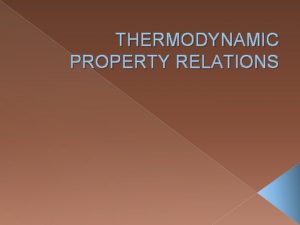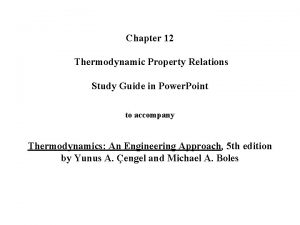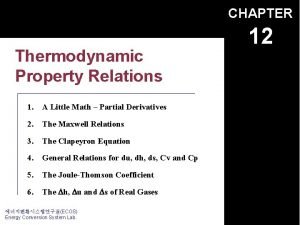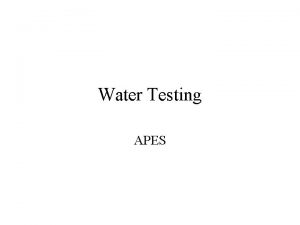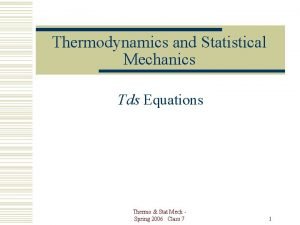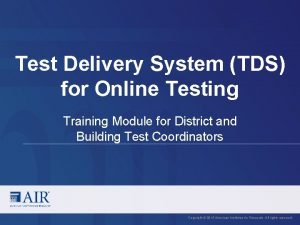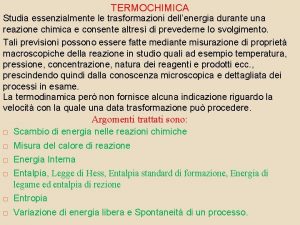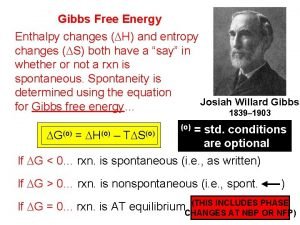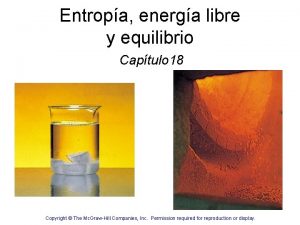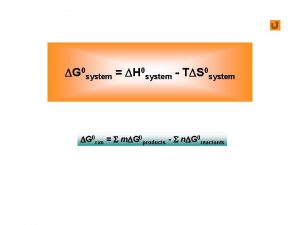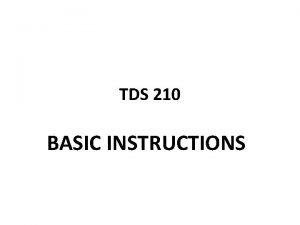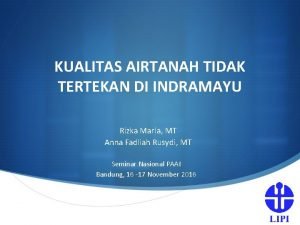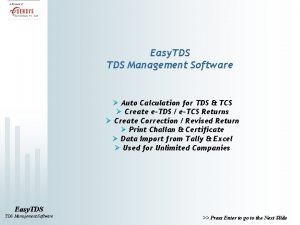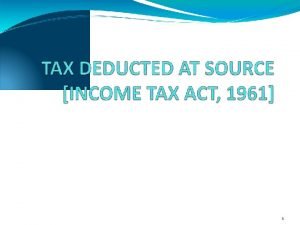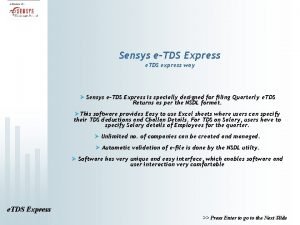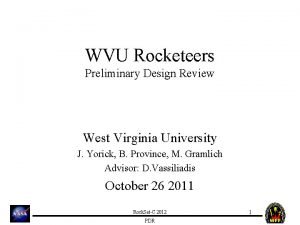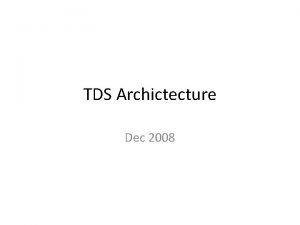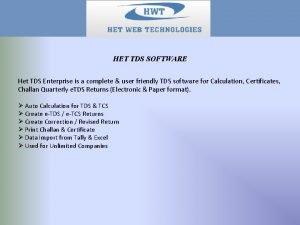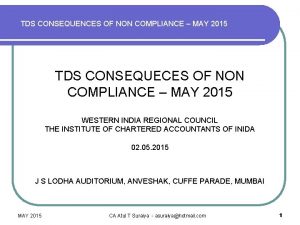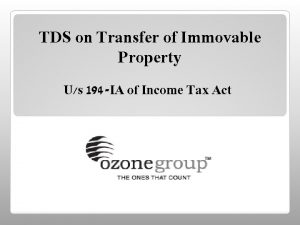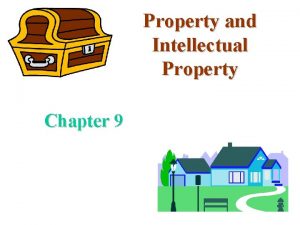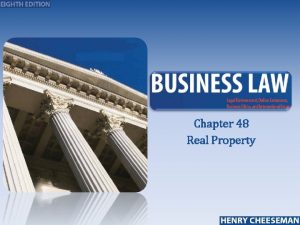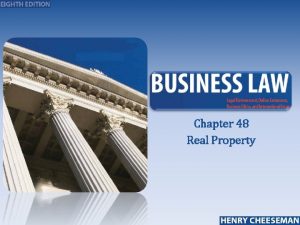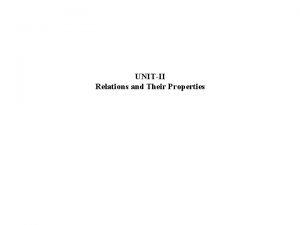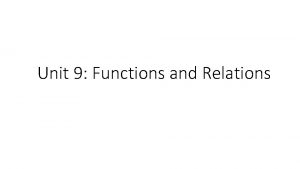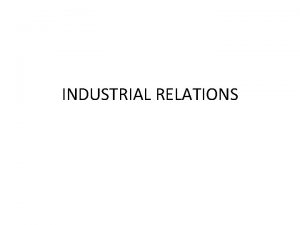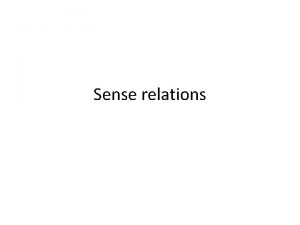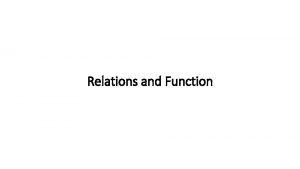Property Relationships Chapter 7 1 The Tds relations














































- Slides: 46

Property Relationships Chapter 7 1

The T-ds relations: Apply the differential form of the first law for a closed stationary system for an internally reversible process 2

Divide by the mass, you get This equation is known as: First Gibbs equation or First T-ds relationship Divide by T, . . Although we get this form for internally reversible process, we still can compute Ds for an irreversible process. This is because S is a point function. 3

Second T-ds (Gibbs) relationship Recall that… Take the differential for both sides Rearrange to find du Substitute in the First Tds relationship Second Tds relationship, or Gibbs equation 4

Divide by T, . . Thus We have two equations for ds To find Ds, we have to integrate these equations. Thus we need a relation between du and T (or dh and T). Now we can find entropy change (the LHS of the entropy balance) for liquids and solids 5

T-ds Eq. 1 &2 are relations between the properties of a unit mass of a simple compressible system as it undergoes a change of state, Even though they were developed for internally reversible process THEN l The T ds relations are valid for both l l reversible and irreversible processes and for both closed and open systems. 6

7 -8: Entropy Change of Liquids and Solids and liquids do not change specific volume appreciably with pressure. That means that dv=0, so the first equation is the easiest to use. 0 Thus For solids and liquids Recall also that For solids and liquids, 7

Integrate to give… Only true for solids and liquids!! What if the process is isentropic? The only way this expression can equal 0 is if, Hence, for solids and liquids (incompressible) , isentropic processes are also isothermal. 8

Example(7 -7): Effect of Density of a Liquid on Entropy Liquid methane is commonly used in various applications. The critical temperature of methane is 191 K (or 82 o. C), and thus methane must be maintained below 191 K to keep it in liquid phase. The properties of liquid methane at various temperatures and pressures are given next page. Determine the entropy change of liquid methane as it undergoes a process from 110 K and 1 MPa to 120 K and 5 MPa (a) using actual data for methane and (b) approximating liquid methane as an incompressible substance. What is the error involved in the later case? 9

Error % = 12. 2 10

Example (7 -19): Entropy generated when a hot block is dropped in a lake A 50 -kg block of iron casting at 500 K is dropped in a large lake that is at 285 K. The block reaches thermal equilibrium with lake water. Assuming an average specific heat of 0. 45 k. J/kg. K for the iron, determine: (a) The entropy change of the iron block, (b) The entropy change of the water lake, (c) the entropy generated during this process. 11

(a) The entropy change of the iron block, we need also to find Q coming out of the system. Tsurr= 285 K (b) The entropy change of the water lake, T=500 K 12

(c) the entropy generated during this process. Choose the iron block and the lake as the system and treat it is an isolated system. Thus Sg = Stot = Ssys + Slake Tsurr= 285 K T=500 K Sg = Stot = -12. 6 + 16. 97 = 4. 32 System boundary 13

3 - The Entropy Change of Ideal Gases, first relation First relation The entropy change of an ideal gas can be obtained by substituting du = Cvd. T and P /T= R/ into Tds relations: integrating 14

Second relation A second relation for the entropy change of an ideal gas for a process can be obtained by substituting dh = Cpd. T and /T= R/P into Tds relations: integrating 15

l The integration of the first term on the RHS can be done via two methods: 1. Assume constant Cp and constant Cv (Approximate Analysis) 2. Evaluate these integrals exactly and tabulate the data (Exact Analysis) 16

Method 1: Constant specific heats (Approximate Analysis) First relation Only true for ideal gases, assuming constant heat capacities Second relation Only true for ideal gases, assuming constant heat capacities 17

Sometimes it is more convenient to calculate the change in entropy per mole, instead of per unit mass k. J/kmol. K Ru is the universal gas constant 18

Method 2: Variable specific heats (Exact Analysis) We use the second relation l We could substitute in the equations for Cv and Cp, and perform the integrations l l l Cp = a + b. T + c. T 2 + d. T 3 But this is time consuming. Someone already did the integrations and tabulated them for us (table A-17) l They assume absolute 0 as the starting point 19

The integral is expressed as: Where is tabulated in Table A-17 Therefore 20

Is s = f (T) only? like u for an ideal gas. Let us see Temperature dependence l l Pressure dependence From this equation, It can be seen that the entropy of an ideal gas is not a function only of the temperature ( as was the internal energy) but also of the pressure or the specific volume. The function s° represents only the temperaturedependent part of entropy 21

How about the other relation l l We can develop another relation for the entropy changed based on the above relation but this will require the definition of another function and tabulating it which is not practical. 22

23

24

Isentropic Processes l l l The entropy of a fixed mass can be changed by 1. Heat transfer, 2. Irreversibilities It follows that the entropy of a system will not change if we have 1. Adiabatic process, 2. Internally reversible process. Therefore, we define the following: 25

Isentropic Processes of Ideal Gases l Many real processes can be modeled as isentropic l Isentropic processes are the standard against which we should measure efficiency l We need to develop isentropic relationships for ideal gases, just like we developed for solids and liquids 26

Constant specific heats (1 st relation) Recall For the isentropic case, DS=0. Thus Recall also from ch 2, the following relations. . … Only applies to ideal gases, with constant 27 specific heats

Constant specific heats (2 nd relation) Recall. . … or Only applies to ideal gases, with constant specific heats 28

Since… and HENCE Which can be simplified to… Third isentropic relationship 29

Full form of Isentropic relations of Ideal Gases Compact form l l Valid for only for 1 - Ideal gas 2 - Isentropic process 3 - Constant specific heats 30

That works if the specific heat constants can be approximated as constant, but what if that’s not a good assumption? We need to use the exact treatment This equation is a good way to evaluate property changes, but it can be tedious if you know the volume ratio instead of the pressure ratio 0 31

s 20 is only a function of temperature!!! Rename the exponential term as Pr , (relative pressure) which is only a function of temperature, and is tabulated on the ideal gas tables ( for air as an ideal gas see table A-17) 32

You can use either of the following 2 equations This is good if you know the pressure ratio but how about if you know only the volume ratio In this case, we use the ideal gas law where Remember, these relationships only hold for ideal gases and 33 isentropic processes tabulated in A-17

Example (7 -10): Isentropic Compression of Air in a Car Engine Air is compressed in a car engine from 22 o. C and 95 k. Pa in a reversible and adiabatic manner. If the compression ratio V 1/V 2 of this piston-cylinder device is 8, determine the final temperature of the air. <Answer: 662. 7 K> Sol: 34

Assuming constant specific heat and assuming k we can have alternative solution The k value at this anticipated average temperature is determined from Table A– 2 b to be 1. 391 35

36

37

Reversible Steady Flow Work 38

For the pump the specific volume is constant so h 2 -h 1 = v (p 2 -p 1) 39

For compressor the specific volume is function of pressure then we use h 2 -h 1 instead of v (p 2 -p 1) which is only used for a pump 40

7 -10: Reversible Steady Flow Work the energy balance for a steady-flow device If the changes in kinetic and potential energies are negligible, Then 41

Reversible work relations for steady flow and closed systems. 42

7– 11 MINIMIZING THE COMPRESSOR WORK l When the changes in kinetic and potential energies are negligible, the compressor work is given by l effect of cooling during the compression process ( PVn = Constant) l an isentropic process (involves no cooling), n =k l a polytropic process (involves some cooling), 1<n<k l an isothermal process (involves maximum cooling). n =1 One common way of cooling the gas during compression is to use 43 cooling jackets around the casing of the compressors.

7– 11 MINIMIZING THE COMPRESSOR Work Win decrease 44

Multistage Compression with Intercooling l l l cooling a gas as it is compressed is desirable since this reduces the required work input to the compressor. often it is not possible to have adequate cooling through the casing of the compressor, effective cooling. One such technique is multistage compression with intercooling, The gas is compressed in stages and cooled between each stage by passing it through a heat exchanger called an intercooler. Ideally, the cooling process takes place at constant pressure, and the gas is cooled to the initial temperature T 1 at each intercooler. 45

4/2=2 4 -2=2 8/4=2 8 -4=4 The Px value that minimizes the total work is determined by differentiating this expression with respect to Px and setting the resulting expression equal to zero. to minimize compression work during two-stage compression, the pressure ratio 46 across each stage of the compressor must be the same. wcomp I, in = wcomp II, in.
 Tds relations
Tds relations Employee relations in public relations
Employee relations in public relations Thermodynamic property relations
Thermodynamic property relations Thermodynamic property relations
Thermodynamic property relations Thermodynamic property relations
Thermodynamic property relations Tds apes
Tds apes Tds equation
Tds equation Online test delivery system
Online test delivery system Entalpia
Entalpia Tds on conference hall rent
Tds on conference hall rent Dg=dh-tds
Dg=dh-tds Energia libre de gibbs reaccion espontanea
Energia libre de gibbs reaccion espontanea Dg=dh-tds
Dg=dh-tds Tds 210
Tds 210 Easytds
Easytds Unicorn vs tds
Unicorn vs tds Tds penumbra
Tds penumbra Easy tds software
Easy tds software Ibuprofen 400mg tds
Ibuprofen 400mg tds Tds
Tds Sleger tds
Sleger tds Tdsexpress
Tdsexpress Rocketeer tds
Rocketeer tds Python tds
Python tds Commutative and associative properties
Commutative and associative properties Classification of property law
Classification of property law Chemical property definition
Chemical property definition Hình ảnh bộ gõ cơ thể búng tay
Hình ảnh bộ gõ cơ thể búng tay Slidetodoc
Slidetodoc Bổ thể
Bổ thể Tỉ lệ cơ thể trẻ em
Tỉ lệ cơ thể trẻ em Chó sói
Chó sói Tư thế worm breton là gì
Tư thế worm breton là gì Hát lên người ơi
Hát lên người ơi Các môn thể thao bắt đầu bằng từ đua
Các môn thể thao bắt đầu bằng từ đua Thế nào là hệ số cao nhất
Thế nào là hệ số cao nhất Các châu lục và đại dương trên thế giới
Các châu lục và đại dương trên thế giới Cong thức tính động năng
Cong thức tính động năng Trời xanh đây là của chúng ta thể thơ
Trời xanh đây là của chúng ta thể thơ Cách giải mật thư tọa độ
Cách giải mật thư tọa độ Phép trừ bù
Phép trừ bù Phản ứng thế ankan
Phản ứng thế ankan Các châu lục và đại dương trên thế giới
Các châu lục và đại dương trên thế giới Thơ thất ngôn tứ tuyệt đường luật
Thơ thất ngôn tứ tuyệt đường luật Quá trình desamine hóa có thể tạo ra
Quá trình desamine hóa có thể tạo ra Một số thể thơ truyền thống
Một số thể thơ truyền thống Bàn tay mà dây bẩn
Bàn tay mà dây bẩn


